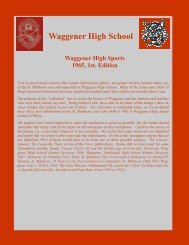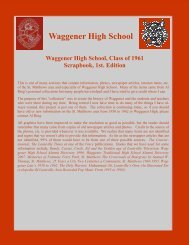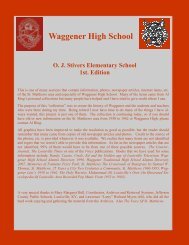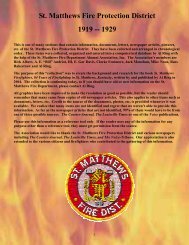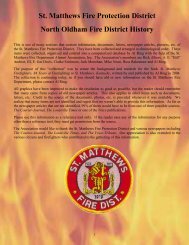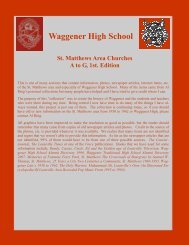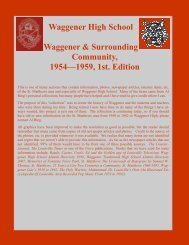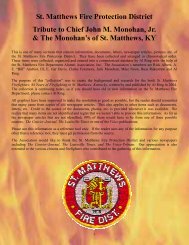Our Era - Movies, Music, Radio and TV, 6th Edition
Our Era - Movies, Music, Radio and TV, 6th Edition
Our Era - Movies, Music, Radio and TV, 6th Edition
Create successful ePaper yourself
Turn your PDF publications into a flip-book with our unique Google optimized e-Paper software.
<strong>Our</strong> <strong>Era</strong> - <strong>Movies</strong>, <strong>Music</strong>, <strong>Radio</strong> & <strong>TV</strong>, 1950‟s <strong>and</strong> 1960‟s. February 3, 1959Courtesy of http://www.fiftiesweb.com/crash.htmThe Day <strong>Music</strong> DiedOn a cold winter's night a small private plane took off from Clear Lake, Iowa bound for Fargo, N.D. It never made itsdestination.When that plane crashed, it claimed the lives of Buddy Holly, Ritchie Valens, J.P. "Big Bopper" Richardson <strong>and</strong> the pilot,Roger Peterson. Three of Rock <strong>and</strong> Roll's most promising performers were gone. As Don McLean wrote in his classicmusic parable, American Pie, it was "the day the music died."Performing in concert was very profitable, <strong>and</strong> Buddy Holly needed the money it provided. "The Winter Dance PartyTour" was planned to cover 24 cities in a short 3 week time frame (January 23 - February 15) <strong>and</strong> Holly would be thebiggest headliner. Waylon Jennings, a friend from Lubbock, Texas <strong>and</strong> Tommy Allsup would go as backup musicians.Ritchie Valens, probably the hottest of the artists at the time, The Big Bopper, <strong>and</strong> Dion <strong>and</strong> the Belmonts would roundout the list of performers.The tour bus developed heating problems. It was so cold onboard that reportedly one of the drummers developed frostbiteriding in it. When they arrived at the Surf Ballroom in Clear Lake, Iowa, they were cold, tired <strong>and</strong> disgusted.Buddy Holly had had enough of the unheated bus <strong>and</strong> decided to charter a plane for himself <strong>and</strong> his guys. At least hecould get some laundry done before the next performance!That night at the Surf Ballroom was magical as the fans went wild over the performers.Jiles P. Richardson, known as The Big Bopper to his fans, was a Texas D.J. who found recording success <strong>and</strong> fame in1958 with the song Chantilly Lace.Richie Valenzuela was only 16 years old when Del-Fi record producer, Bob Keane, discovered the Pacoima, Californiasinger. Keane rearranged his name to Ritchie Valens, <strong>and</strong> in 1958 they recorded Come On, Let's Go. Far more successfulwas the song Valens wrote for his girlfriend, Donna, <strong>and</strong> its flip side, La Bamba, a Rock <strong>and</strong> Roll version of an old Mexicanst<strong>and</strong>ard. This earned the teenager an appearance on American B<strong>and</strong>st<strong>and</strong> <strong>and</strong> the prospect of continued popularity.Charles Hardin "Buddy" Holley (changed to Holly due to a misspelling on a contract) <strong>and</strong> his b<strong>and</strong>, The Crickets, had anumber one hit in 1957 with the tune That'll Be The Day. This success was followed by Peggy Sue <strong>and</strong> an appearance onthe Ed Sullivan Show. By 1959, Holly had decided to move in a new direction. He <strong>and</strong> the Crickets parted company.Holly married Maria Elena Santiago <strong>and</strong> moved to New York with the hope of concentrating on song writing <strong>and</strong> producing.Dwyer Flying Service got the charter. $36 per person for a single engine Beechcraft Bonanza.Waylon Jennings gave his seat up to Richardson, who was running a fever <strong>and</strong> had trouble fitting his stocky frame comfortablyinto the bus seats.When Holly learned that Jennings wasn't going to fly, he said, "Well, I hope your old bus freezes up." Jennings responded,"Well, I hope your plane crashes." This friendly banter of friends would haunt Jennings for years.




